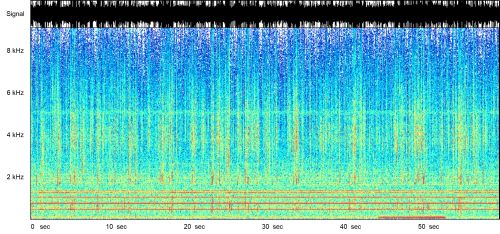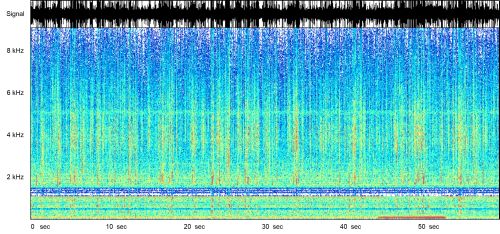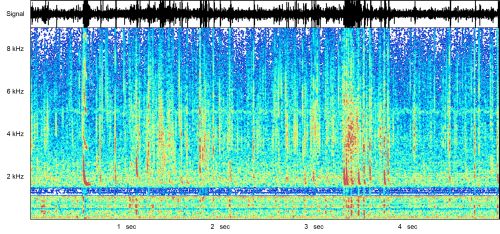Spherics and Tweeks
Joachim Köppen Kiel 2018
Click on blue-rimmed images to enlarge.
Any electrical discharge by a spark or a lightning produces a short sharp pulse of
radio emission, which can be heard on frequencies between a few 100 Hz and several
MHz: This can be easily demonstrated by charging an electrolythic capacitor (of 1000 µF)
with a voltage of 12 V. When you short circuit its terminals, you'll see a small spark.
Place a radio receiver nearby, and you'll hear a sharp 'click', especially in the AM bands,
but also in the FM band. If you operate a gas lighter (or a cigarette lighter), which
produces a spark from the voltage caused by stressing a piezoelectric material, you'll
make the same observations.
When a thunderstorm approaches, you may hear crashing sounds on an AM radio on the long and
medium wave bands, which had been used for broadcasting until a few years ago. A crash occurs
everytime you see the flash of a lightning. These atmospheric noises of 'spherics'
are the sharp radio pulses produced by the electrical discharge of a lightning. A short
pulse consists of emission over a wide range of frequencies.
Since the ionosphere - a layer of ionized atmospheric gas at heights between about 100 to 600 km
above the ground - and the ground surface of the Earth both are good or relatively good electrical
conductors, they both reflect radio waves with frequencies below a few MHz. Thus, the radio waves
from the lightning are trapped between Earth and ionosphere and can travel a long distance:
At very low frequencies the pulse from a strong lightning can easily be heard at distances of
several hundreds or a few thousands of kilometers.
Any time of the day and at any time of the year one can hear the clicks and noises from
lightnings near and far. Of course during local summer there are more thunderstorms nearby
and hence more and louder spherics. All over the Earth one counts about 50 lightnings per
second.
The ionosphere is produced by ultraviolet radiation from the sun, which splits
the molecules of the atmospheric gases and ionizes the nitrogen and oxygen atoms. But as this
is strongest during the day, the ionosphere is strongest during daytime. Thus its lowest layers
(at 100 km height) will also absorb radio waves. When the solar radiation disappears at sunset,
the ionosphere becomes weaker, and the absorption also disappears. Thus radio waves with
frequencies below about 5 MHz are able to propagate to greater distances. On long and medium
wave AM radio this was quite noticeable, as one could listen to more and more distant stations
in the evening and at night.
This also applies with the spherics in the VLF range: the noise is stronger at night time.
Radio waves that travel over longer distances also have to pass a longer time through
the ionized plasma of the ionosphere, while they are reflected. The speed of a radio wave
traveling through a plasma depends on its frequency, with lower frequencies travelling more
slowly. This is called 'dispersion'.
Thus in spherics from great distances the various frequencies no longer reach
the receiver at the same time, but the lower frequencies come a bit later. This gives
the pulse a slight musical sound: it does not appear like a sharp 'click' but sounds more
like 'pling' or 'twang', resembling a plucked guitar string. These sounds are called 'Tweeks'.
They appear at the time of sunset, from any thunderstorms to the east of the receiver.
There is another effect: Since the ionosphere and the ground surface form a waveguide
for the radio waves, any signals with wavelengths longer than twice the height of the
waveguide cannot travel through the waveguide (this applies to any waves, including
water waves which cannot travel through a canal too narrow ...). Therefore, the tweeks
also lack frequencies lower than a certain limit frequency:
As it will be shown below, this cut-off frequency is about 1.6 kHz. A radio wave with
this frequency has a wavelength of 3000000 km/s / 1.6 kHz = 190 km. Hence the height of
the waveguide is half that wavelength: 95 km. This is the height of the bottom of the
ionosphere at night.
On 7 aug 2006 at UT 23:15 I was on the car park in the square in front
of my house, testing a new version of the receiver. The recording showed
many spherics, quite a number of tweeks, and of course the hum from the electric
power lines:

listen to the sound file
With the Audacity program one can filter
out the frequencies of electric hum quite well:

listen to the sound file
In the first 5 seconds of the recording there is a nice, loud, and distinct
tweek and a group of less musical tweeks:

listen to the sound file
By modeling the time-dependence of the frequency, one may determine
the height of the reflecting ionosphere and the distance that the
radio pulse must have travelled:
| Top of the Page | Back to the MainPage | to my JavaScript Tools | to my Java Applets | to my HomePage |
last update: Apr 2018 J.Köppen